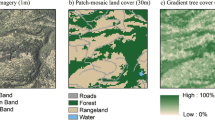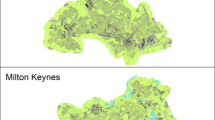Abstract
Although landscape configuration and landscape composition metrics are correlated theoretically and empirically, the effectiveness of configuration metrics from composition metrics has not been explicitly investigated. This study explored to what extent substantial information of configuration metrics increases from certain easily calculated and extensively used composition metrics and how strongly the effectiveness is influenced by different factors. The effectiveness of 12 landscape configuration metrics from the percentage of landscape (PLAND) of each land-use class and patch density (PD) was evaluated through the coefficient of determination (R 2) of multivariate stepwise linear regression analysis of 150 town-based landscape samples from three regions. The different landscape configuration metrics from PLAND and PD presented significantly different performances in terms of effectiveness [the contagion index and aggregation index possess minimal information, and the effective mesh size (MESH) and area-weighted mean patch fractal dimension possess abundant information]. Furthermore, the effectiveness of configuration metrics showed different responses to changing cell sizes and different land-use categorization in different regions (interspersion and juxtaposition index, patch cohesion index, and MESH exhibited large variations in R 2 among the different regions). No single, uniform, consistent characteristic of effectiveness was determined across different factors. This new approach to understanding the effectiveness of configuration metrics helps clarify landscape metrics and is fundamental to landscape metric assessment.




Similar content being viewed by others
References
Bailey D, Herzog F, Augenstein I et al (2007) Thematic resolution matters: indicators of landscape pattern for European agro-ecosystems. Ecol Indic 7(3):692–709
Braimoh AK (2006) Random and systematic land-cover transitions in northern Ghana. Agric Ecosyst Environ 113(1–4):254–263
Buyantuyev A, Wu J (2007) Effects of thematic resolution on landscape pattern analysis. Landsc Ecol 22(1):7–13
Congalton RG (1997) Exploring and evaluating the consequences of vector-to-raster and raster-to-vector conversion. Photogramm Eng Remote Sens 63(4):425–434
Corry RC, Lafortezza R (2007) Sensitivity of landscape measurements to changing grain size for fine-scale design and management. Landsc Ecol Eng 3(1):47–53
Cushman SA, McGarigal K, Neel MC (2008) Parsimony in landscape metrics: strength, universality, and consistency. Ecol Indic 8(5):691–703
Dendoncker N, Schmit C, Rounsevell M (2008) Exploring spatial data uncertainties in land-use change scenarios. Int J Geogr Inf Sci 22(9):1013–1030
Frohn RC (2006) The use of landscape pattern metrics in remote sensing image classification. Int J Remote Sens 27(10):2025–2032
Geri F, Amici V, Rocchini D (2010) Human activity impact on the heterogeneity of a Mediterranean landscape. Appl Geogr 30(3):370–379
Griffith JA, Martinko EA, Price KP (2000) Landscape structure analysis of Kansas at three scales. Landsc Urban Plan 52(1):45–61
Herold M, Couclelis H, Clarke KC (2005) The role of spatial metrics in the analysis and modeling of urban land use change. Comput Environ Urban Syst 29(4):369–399
Huang C, Geiger EL, Kupfer JA (2006) Sensitivity of landscape metrics to classification scheme. Int J Remote Sens 27(14):2927–2948
Hung W-C, Chen Y-C, Cheng K-S (2010) Comparing landcover patterns in Tokyo, Kyoto, and Taipei using ALOS multispectral images. Landsc Urban Plan 97(2):132–145
IBM Corp R (2010) IBM SPSS statistics for windows, version 19.0. IBM, Armonk, NY
Jiao L, Liu Y, Li H (2012) Characterizing land-use classes in remote sensing imagery by shape metrics. ISPRS J Photogramm Remote Sens 72:46–55
Kromroy K, Ward K, Castillo P, Juzwik J (2007) Relationships between urbanization and the oak resource of the Minneapolis/St. Paul Metropolitan area from 1991 to 1998. Landsc Urban Plan 80(4):375–385
Kweon BS, Ellis CD, Leiva PI, Rogers GO (2010) Landscape components, land use, and neighborhood satisfaction. Environ Plan B Plan Des 37(3):500
Lausch A, Herzog F (2002) Applicability of landscape metrics for the monitoring of landscape change: issues of scale, resolution and interpretability. Ecol Indic 2(1):3–15
Lausch A, Blaschke T, Haase D et al (2015) Understanding and quantifying landscape structure—a review on relevant process characteristics, data models and landscape metrics. Ecol Model 295:31–41
Lechner AM, Reinke KJ, Wang Y, Bastin L (2013) Interactions between landcover pattern and geospatial processing methods: effects on landscape metrics and classification accuracy. Ecol Complex 15:71–82
Li X, Zhou W, Ouyang Z (2013) Relationship between land surface temperature and spatial pattern of greenspace: what are the effects of spatial resolution? Landsc Urban Plan 114:1–8
Liu Y, Jiao L, Liu Y (2011) Analyzing the effects of scale and land use pattern metrics on land use database generalization indices. Int J Appl Earth Obs Geoinf 13(3):346–356
Long JA, Nelson TA, Wulder MA (2010) Characterizing forest fragmentation: distinguishing change in composition from configuration. Appl Geogr 30(3):426–435
Mairota P, Cafarelli B, Boccaccio L et al (2013) Using landscape structure to develop quantitative baselines for protected area monitoring. Ecol Indic 33:82–95
McGarigal K, Cushman S, Ene E (2012) FRAGSTATS v4: spatial pattern analysis program for categorical and continuous maps. University of Massachusettes, Amherst, MA. URL http://www.umass.edu/landeco/research/fragstats/fragstats.html
Morelli F, Pruscini F, Santolini R, Perna P, Benedetti Y, Sisti D (2013) Landscape heterogeneity metrics as indicators of bird diversity: determining the optimal spatial scales in different landscapes. Ecol Indic 34:372–379
Neel MC, McGarigal K, Cushman SA (2004) Behavior of class-level landscape metrics across gradients of class aggregation and area. Landsc Ecol 19(4):435–455
Pasher J, Mitchell SW, King DJ, Fahrig L, Smith AC, Lindsay KE (2013) Optimizing landscape selection for estimating relative effects of landscape variables on ecological responses. Landscape Ecol 28(3):371–383
Paudel S, Yuan F (2012) Assessing landscape changes and dynamics using patch analysis and GIS modeling. Int J Appl Earth Obs Geoinf 16:66–76
Pecher C, Tasser E, Walde J, Tappeiner U (2013) Typology of Alpine region using spatial-pattern indicators. Ecol Indic 24:37–47
Peng J, Wang Y, Ye M, Wu J, Zhang Y (2007) Effects of land-use categorization on landscape metrics: a case study in urban landscape of Shenzhen, China. Int J Remote Sens 28(21):4877–4895
Peng J, Wang Y, Zhang Y, Wu J, Li W, Li Y (2010) Evaluating the effectiveness of landscape metrics in quantifying spatial patterns. Ecol Indic 10(2):217–223
Plexida SG, Sfougaris AI, Ispikoudis IP, Papanastasis VP (2014) Selecting landscape metrics as indicators of spatial heterogeneity—a comparison among Greek landscapes. Int J Appl Earth Obs Geoinf 26:26–35
Proulx R, Fahrig L (2010) Detecting human-driven deviations from trajectories in landscape composition and configuration. Landsc Ecol 25(10):1479–1487
Rayburn AP, Schulte LA (2009) Landscape change in an agricultural watershed in the US Midwest. Landsc Urban Plan 93(2):132–141
Rempel R, Kaukinen D, Carr A (2012) Patch analyst and patch grid. Ontario Ministry of Natural Resources. Centre for Northern Forest Ecosystem Research, Thunder Bay
Saura S (2002) Effects of minimum mapping unit on land cover data spatial configuration and composition. Int J Remote Sens 23(22):4853–4880
Shortridge AM (2004) Geometric variability of raster cell class assignment. Int J Geogr Inf Sci 18(6):539–558
Šímová P, Gdulová K (2012) Landscape indices behavior: a review of scale effects. Appl Geogr 34:385–394
Su S, Jiang Z, Zhang Q, Zhang Y (2011) Transformation of agricultural landscapes under rapid urbanization: a threat to sustainability in Hang-Jia-Hu region, China. Appl Geogr 31(2):439–449
Su S, Xiao R, Jiang Z, Zhang Y (2012) Characterizing landscape pattern and ecosystem service value changes for urbanization impacts at an eco-regional scale. Appl Geogr 34:295–305
Szabó S, Túri Z, Márton S (2014) Factors biasing the correlation structure of patch level landscape metrics. Ecol Indic 36:1–10
Tian G, Qiao Z, Zhang Y (2012) The investigation of relationship between rural settlement density, size, spatial distribution and its geophysical parameters of China using Landsat TM images. Ecol Model 231:25–36
Tian Y, Jim CY, Wang H (2014) Assessing the landscape and ecological quality of urban green spaces in a compact city. Landsc Urban Plan 121:97–108
Uuemaa E, Mander Ü, Marja R (2013) Trends in the use of landscape spatial metrics as landscape indicators: a review. Ecol Indic 28:100–106
Wu J (2006) Landscape ecology, cross-disciplinarity, and sustainability science. Landsc Ecol 21(1):1–4
Wu J, Shen W, Sun W, Tueller PT (2002) Empirical patterns of the effects of changing scale on landscape metrics. Landsc Ecol 17(8):761–782
Zaragozí B, Belda A, Linares J, Martínez-Pérez J, Navarro J, Esparza J (2012) A free and open source programming library for landscape metrics calculations. Environ Model Softw 31:131–140
Zhou W, Huang G, Cadenasso ML (2011) Does spatial configuration matter? Understanding the effects of land cover pattern on land surface temperature in urban landscapes. Landsc Urban Plan 102(1):54–63
Acknowledgements
This paper is supported by the Key Laboratory for Digital Land and Resources of Jiangxi Province, East China University of Technology (Grant No. DLLJ201610), the Doctoral Scientific Research Foundation of East China University of Technology (Grant No. DHBK2015311) and the key laboratory of watershed ecology and geographical environment monitoring, NASG (Grant No. WE2016018).
Author information
Authors and Affiliations
Corresponding author
Rights and permissions
About this article
Cite this article
Wei, X., Xiao, Z., Li, Q. et al. Evaluating the effectiveness of landscape configuration metrics from landscape composition metrics. Landscape Ecol Eng 13, 169–181 (2017). https://doi.org/10.1007/s11355-016-0314-6
Received:
Revised:
Accepted:
Published:
Issue Date:
DOI: https://doi.org/10.1007/s11355-016-0314-6




